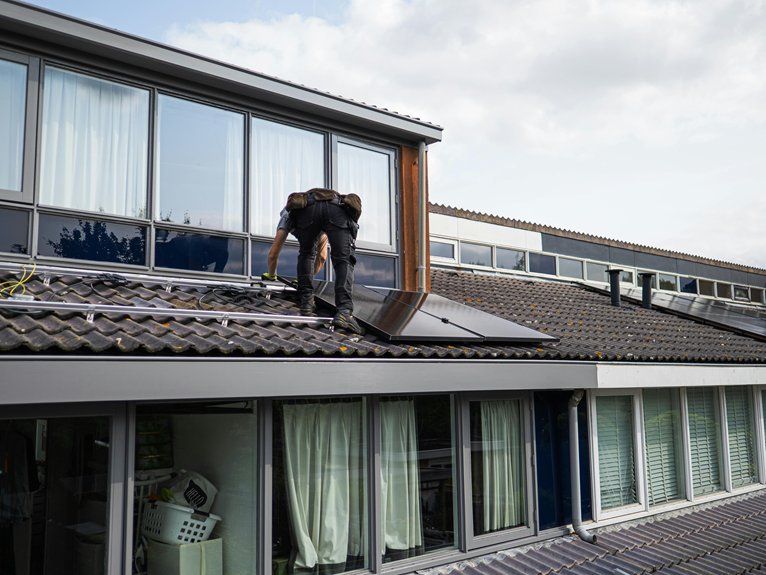Maintaining a flat roof in Krum requires vigilance to prevent minor issues from escalating into costly repairs. Regular inspections for damage, debris buildup, and water pooling are essential, as is keeping gutters and drainage systems clear. Addressing small repairs quickly and ensuring proper slope and drainage are maintained can extend your roof’s lifespan. Staying proactive with these practices helps avoid unexpected failures—yet, understanding the specific steps to implement them effectively is critical for long-term roof performance.
Regularly Inspect Your Roof for Damage and Debris
Regularly inspecting your flat roof for damage and debris is essential to maintaining its integrity and preventing costly repairs. Focus on identifying cracks, blisters, or punctures in the roof coating, as these compromise waterproofing. Check for pooling water, which indicates drainage issues, and inspect the membrane sealing for signs of deterioration or lifting. Being aware of your roofing system’s benefits and services can help you better understand maintenance needs. Remove accumulated debris like leaves and dirt that can trap moisture, promoting deterioration. Pay close attention to areas around seams, penetrations, and edges, where damage is more likely. Proper membrane sealing guarantees a continuous, watertight surface, while an effective roof coating protects against UV rays and weathering. Conduct these inspections biannually and after severe weather to catch issues early, preserving your roof’s lifespan and performance.
Keep Gutters and Drains Clear of Obstructions
To prevent water accumulation and potential roof damage, it’s essential to keep gutters and drains free of obstructions. Regular gutter cleaning removes leaves, twigs, and debris that can clog the system, ensuring proper water flow.
Drain clearing involves inspecting and removing blockages in downspouts and drainage pipes, preventing overflow during heavy rainfall. Use a sturdy ladder and gloves during gutter cleaning to access and clear debris safely.
For drain clearing, consider using a plumber’s auger or high-pressure water jet to dislodge stubborn obstructions. Ensure all components are securely attached and free of damage after cleaning.
Maintaining clear gutters and drains minimizes standing water, reduces the risk of leaks, and prolongs your flat roof’s lifespan. Consistent attention to these systems is critical for effective roof preservation.
Address Small Repairs Promptly to Prevent Larger Issues
Addressing small repairs immediately is essential for maintaining the integrity of your flat roof and preventing minor issues from escalating into costly, extensive damage. Small punctures or tears in the roof membrane can lead to water infiltration if left unattended.
Regular inspection allows you to identify early signs of deterioration, such as cracks or blisters. Prompt flashing repair is critical around roof penetrations and edges to prevent leaks. Use appropriate sealants and patching materials designed for your roof membrane type, ensuring a seamless, watertight seal.
Ignoring minor damages increases the risk of membrane failure and water intrusion, leading to structural damage and mold growth. Swiftly addressing these issues preserves roof longevity and minimizes repair costs over time.
Ensure Proper Drainage and Slope Maintenance
Proper drainage and slope maintenance are essential to preventing water accumulation that can compromise your flat roof’s integrity. Regularly inspect your drainage systems, including drains, scuppers, and gutters, for blockages or debris that hinder water flow.
Make certain that the roof slope directs water toward these outlets efficiently. Over time, slope adjustments may be necessary to maintain proper drainage, especially if settling or minor shifts occur in the roof structure.
Use level tools and visual assessments to identify areas where water pools or drainage is sluggish. Promptly addressing drainage system obstructions and maintaining correct slope angles reduce standing water risks, minimize ponding, and extend your roof’s lifespan.
Consistent upkeep of these elements is crucial for effective water runoff and overall roof health.
Schedule Professional Roof Inspections and Maintenance
Scheduling regular professional roof inspections is essential for early detection of potential issues that may not be visible during routine maintenance. During these inspections, experts assess the integrity of your roof coating, checking for cracks, blisters, or signs of deterioration that could compromise waterproofing.
Leak detection is a critical component, with specialists using moisture meters and infrared imaging to identify hidden leaks beneath the surface. Timely identification allows you to address minor problems before they escalate into costly repairs or structural damage.
Routine inspections also evaluate drainage systems and surface conditions, ensuring proper slope and debris removal. Implementing a proactive maintenance schedule enables you to extend your roof’s lifespan, maintain energy efficiency, and prevent unexpected failures that disrupt your business operations.
Conclusion
Maintaining your flat roof in Krum requires consistent inspections and timely repairs. By regularly checking for damage, debris, and pooling water, and ensuring gutters and drainage systems are clear, you prevent costly issues. Promptly addressing small cracks and punctures helps avoid larger structural problems. Scheduling professional inspections guarantees hidden issues are identified early. For more information on how to schedule your free roof inspection, call us at (405) 543-2920 or visit us online at Top View Roofing. This proactive approach maximizes your roof’s lifespan, maintains peak performance, and protects your investment from weather-related deterioration.











